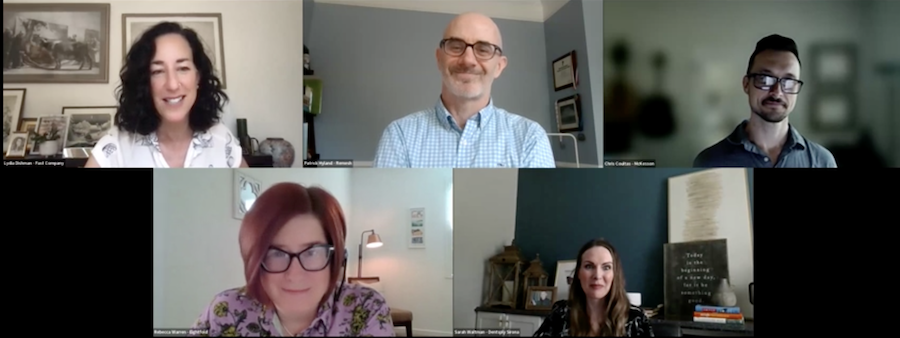Leveraging New Technology to Gain Insight into Workforce Engagement


Depending on who you ask, AI could either be a threat or a miracle. Regardless of your stance, the reality lies in its application: AI is an evolving tool that, when leveraged effectively, can offer powerful insight into your workforce, ultimately driving decision-making and strategic planning.
Patrick Hyland, organizational psychologist and strategic advisor at Remesh, an AI-powered employee listening platform, says there’s potential for real transformation from AI within employee research. However, as savvy as the new tech is, people should have a healthy dose of skepticism to see where the potential pitfalls lie.
Hyland and other leaders spoke about AI and innovative technology during an executive panel at From Day One’s August virtual conference. Lydia Dishman of Fast Company moderated the discussion.
“I really need to experiment with the technology,” said Hyland. “I need to try it, verify it, and suss out the strengths of the technology, and how that squares up with my traditional methods to figure out where the synergistic point is,” he said.
The ultimate test is whether the technology benefits both employees and the organization. If it does, the next step is scaling it. “AI is taking this overwhelming amount of data and turning it into employee-led suggestions for progress,” Hyland said.
For this to work, organizations must build trust, ensuring employees know who will see survey results and how the data will be used. “If you don’t have that psychological safety, no one will participate fully.”
Turning Automation into Action
Tapping into the strengths of AI is key, panelists acknowledged. Chris Coultas, Ph.D., senior director, employee performance and engagement at McKesson, says the organization of more than 50,000 relies on regular surveys to offer insight into how to help employee engagement.
AI can handle the vast amount of data, developing survey questions, automating administration, and identifying patterns. “The biggest value is in understanding and acting on the data that you get,” Coultas said. AI can integrate data streams and provide actionable insights, helping leaders take effective actions.
“With AI you almost have your own engagement coach,” he said. It can help build an engagement calendar with actionable steps, keeping the momentum going between surveys.

The data and automation of the AI tool is only truly leveraged effectively if those actions are indeed taken, but communicating this is part of the equation. “You should be going back to your team and saying, ‘This is what I think you’re saying. This is what I’m hearing so far. Did I get that right?’” Then you can work together to develop those actionable steps together, he says.
Taking a Customized Approach
Another key to leveraging AI to increase engagement is customizing content, says Rebecca Warren, director of talent centered transformation at Eightfold.
“When we use tech to understand what people want, [like] where they’re at and what they need, we’re developing that culture of continuous learning. So it becomes proactive instead of reactive. We’re not serving things up to people and saying, ‘take this training.’” This kind of customization helps meet each individual where they are and elevates them, making employees feel seen and increasing engagement.
AI can also help potential hires be seen. It can detect bias, write more inclusive job descriptions, and help recruiters look more at skills. “Tech can also help open up that pipeline, making that a wider reach, getting the information out to more people, and also helping people share it more easily,” said Warren.
AI can then be used to collect and analyze data on the diversity of the pipeline. “So, it’s using tech to collect and analyze that data and then help organizations identify areas where they may need or want to improve,” she said.
Ethical AI Use
From data collection, to analysis, to implementation, organizations should be cautious and ensure they’re using AI and new technology ethically. “We have to be cautious to not weaponize the feedback or allow leaders who might not agree with the feedback to become frustrated,” said panelist Sarah Waltman, VP, global talent management and organizational development at Dentsply Sirona.
Something AI can’t do for leaders is show empathy and understanding, even if they don’t agree with it. Along with that is transparency. Leaders should share the purpose of new tech and tie it to business priorities to ensure employee buy-in.
“You have to share with your organization ‘the what and the why’ of the new tech way before it actually shows up and tie it to business priorities,” she said. Establishing clear ROI expectations and maintaining an open conversation about new tech are crucial.
“I am 100% for tech. But I think that the human loop needs to stay connected for that context, for that continuity, for the folks to feel like it’s ethically done. So that human loop and letting people feel listened to and heard, to me, kind of puts that cherry on the top,” said Waltman.
By effectively leveraging AI while maintaining a human-centered approach, organizations can enhance workforce engagement and drive meaningful progress.
Carrie Snider is a Phoenix-based journalist and marketing copywriter.
The From Day One Newsletter is a monthly roundup of articles, features, and editorials on innovative ways for companies to forge stronger relationships with their employees, customers, and communities.